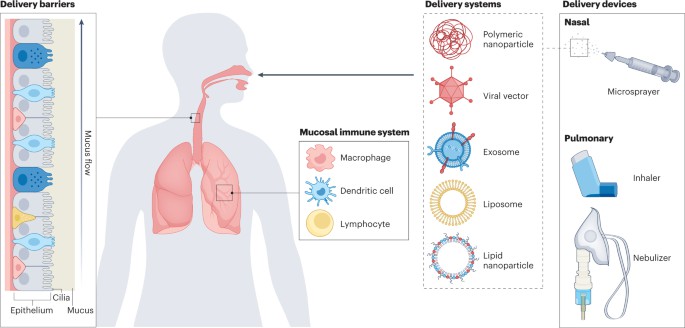Inhalation/Nasal delivery is a method of administering medicine by inhaling it through the nose. As we all know, the nasal mucosa surface is smooth, moist and rich in blood vessels, and medication can quickly take effect locally through nasal drops or inhalation. Compared to traditional drug delivery methods, this non-invasive method has the advantages of faster drug efficacy, higher bioavailability, and fewer systemic side effects. Moreover, inhalation/nasal delivery can bypass the first-pass metabolism effect of the gastrointestinal tract and liver, significantly improving drug absorption and bioavailability. Therefore, this method of drug delivery is increasingly favored by pharmaceutical researchers.
The notion of treating respiratory and nasal diseases with inhalation and nasal delivery is a scientific leap that has revolutionized the way we approach diseases like asthma, chronic obstructive pulmonary disease (COPD), cystic fibrosis, and allergic rhinitis. These ailments are often localized to specific respiratory tract regions, underscoring the need for targeted delivery to achieve the desired therapeutic effect. Inhalation and nasal delivery boast of a rapid onset of action, a critical feature in managing acute respiratory conditions.
When it comes to targeted delivery, nanoparticles are game-changers in the field. These microscopic particles have proven to be effective in delivering drugs to the respiratory tract with impressive precision. The use of liposomes and solid lipid nanoparticles is a case in point. These innovative drug carriers have shown promise in delivering drugs like corticosteroids and bronchodilators, which are vital in managing asthma and COPD. Even dendrimers, which are branching molecules with an architecture similar to a tree, have made significant strides in targeted drug delivery to the respiratory tract.
It's noteworthy that the FDA has already approved Arnuity Ellipta, a nano-delivery product designed for inhalation-based drug delivery. This dry powder inhaler packs a punch by delivering fluticasone furoate to the respiratory tract, making it an indispensable tool in the treatment of respiratory conditions. And the clinical cases of inhalation and nasal delivery's success stories in treating an array of respiratory and nasal conditions are a testament to the incredible potential of this mode of drug delivery.
Compared to traditional oral and injection methods of drug delivery, inhalation/nasal delivery has many advantages. One of the main advantages is its rapid onset of action. Medications delivered through this route can quickly reach the target area, thus accelerating the therapeutic effect. In addition, inhalation/nasal delivery significantly improves drug bioavailability because it does not pass through the gastrointestinal tract and liver's first-pass metabolism.
Inhalation/nasal delivery harbors a multifaceted range of benefits, including its non-invasive nature, which avoid potential infectious and slashes medical consumable costs. Moreover, this delivery offers targeted drug delivery design, allowing drug conveyance to the respiratory system and systemic circulation. Such targeting reduces the risk of systemic side effects and toxicity, while concurrently heightening drug efficacy. What's more, the gamut of drugs this mode of delivery can accommodate, including peptides, proteins, small molecules, and nanoparticles, facilitates its ubiquity in the drug delivery arena.
But despite these laudable advantages, certain issues remain that require careful consideration in drug delivery. Precise dosage delivery constitutes one of the main stumbling blocks, particularly for small particles and nanoparticles. Targeting the intended site and delivering the exact dose could be a challenging thing. Additionally, inhalation/nasal delivery is predisposed to various nasal biological barriers, including mucus, cilia, and epithelial cells, which often inhibit drug absorption and limit bioavailability. It is imperative to note that the heterogeneity of these barriers between individuals could impact the effectiveness of inhalation/nasal delivery. Moreover, it bears mentioning that inhalation/nasal delivery could incite nasal mucosal irritation and inflammation, leading to adverse reactions such as sneezing, runny nose, and nasal congestion. In the same vein, the deposition of drug particles in the lungs can engender toxicity and inflammation, culminating in respiratory issues.
 Figure 1. Intranasal and inhaled vaccine delivery.
Figure 1. Intranasal and inhaled vaccine delivery.
Fortunately, several strategies can be employed to surmount these biological barricades. These include the use of nanoparticles, liposomes, and cyclodextrins. For instance, a study by Pramanik S. et al. (2021) demonstrated the effectiveness of nanoparticle systems in delivering the anti-tuberculosis drug isoniazid. These nanoparticles were tailored to permeate the mucus barrier and target the epithelial cells, leading to heightened drug efficacy and reduced toxicity. Additionally, the application of nasal delivery enhancers such as chitosan and hyaluronic acid can augment drug absorption by transiently disrupting the tight junctions between epithelial cells. An investigation by Assadpour S, et al. (2022) underscored the efficacy of chitosan-coated liposomes in bolstering the absorption of the anti-migraine drug sumatriptan in the nasal cavity, augmenting its therapeutic efficacy.
Advantages of Nanoparticles in Inhaled Drug Delivery:
CD Bioparticles is specialized in the development of drug delivery systems and customizing nanoparticles for drug delivery utilizing our core technologies. With our high-quality products and services, the efficacy of your drug delivery can be tremendously improved.
We offer custom synthesis of polymer microspheres and nanoparticles. Clients may select the material type, particle size, size distribution, color dye, fluorescent dye, and/or surface functional groups such as carboxyl or amine groups. We also encapsulate proteins, steroids, ligands, nucleic acids, and other drug molecules. Additionally, the surface coating of microspheres or nanoparticles with ligands, oligonucleotides, and other agents are available for clients to choose.
References
1. Download the template.
2. Enter product information on the template (maximum number of products: 200).
3. Load the file using selector below.
1. Download the template.
2. Enter product information on the template (maximum number of products: 200).
3. Load the file using selector below.